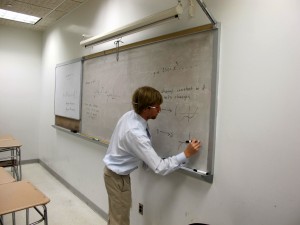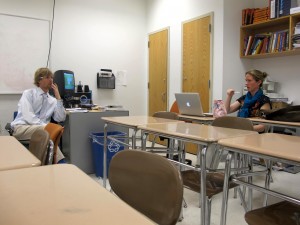
The white board in Room 7 at the Urban Assembly School for Applied Math and Science was a picture of mathematical rigor. Tim Jones, one of the school’s veteran math teachers, had spent the past hour filling it with polynomial equations, graphs and questions in an attempt to make sure that the students at Urban Assembly walked away from the lesson with a very thorough understanding of the material.
But Jones wasn’t actually working with any students this Wednesday afternoon. In fact, the only other person in the classroom was Ellie Weille, a first-year math teacher at Urban Assembly who was working with Jones to figure out how to maximize the lesson’s effectiveness before she went live with it on Friday.
“Explain what happens to the graph when you change the constant,” said Weille, trying to come up with the best way to phrase a question that would successfully demonstrate student comprehension.
“So they could say, ‘It moves up and down,’” responded Jones. “You want a more specific answer than that, so what could you ask instead?”
Weille paused. “Explain what happens to the roots, the shape, and the y-intercept?” she asked.
“Here’s what I’m getting at,” said Jones. “What strategy do you want them going through in their head? What’s the kind of thinking you want them to have?”
Meetings like this are common at Urban Assembly, a public school in the South Bronx that teaches students in grades six through 12. Teachers almost always complete tasks such as lesson planning and curriculum development collaboratively and under the guidance of “team leaders,” typically more experienced teachers who have previously taught the class they are team leading. It is one of the main ways Urban Assembly and other schools work to help support, counsel, and enrich their teaching staff.
“People learn by watching people and talking to people who know more than they do,” said Ann Cook, co-director of New York City’s Urban Academy Laboratory High School. “You want to learn how to teach? You have to spend time with teachers who know what they’re doing.”
This strategy seems to be working so far. In a 2008 working paper about mentoring teachers in New York City schools written by Columbia Business Professor Jonah E. Rockoff and published by the National Bureau of Economic Research, Rockoff found that student achievement was higher in both math and reading “among teachers that received more hours of mentoring.” The paper also found that teachers with mentors were more likely to remain at their schools, provided that their mentor had worked in that school before.
Urban Academy provides all of its new teachers with mentors—generally a senior member of the staff—when they begin working at the school. According to Cook, Urban Academy does not even really consider its staff members teachers until they have been there for two years. Before then, she said, “We consider them beginning teachers.”
Urban Assembly has veteran teachers serve as mentors for younger ones as well. However, this is just one aspect of teacher support at the school. Just as important as the team leaders, according to Principal Ken Baum, are a teacher’s teammates.
Staff members at Urban Assembly made a conscious decision to have multiple teachers—particularly those in middle school—teach the same subjects and share the same responsibilities. Rather than having one sixth grade math teacher and one sixth grade science teacher, for example, the school has two teachers who are both charged with teaching sixth grade math and sixth grade science.
The purpose of this structure is to help newer teachers deal with what Baum cited as their primary concern: what to teach and how to teach it. These two questions become much easier to answer when more than one teacher is trying to figure them out.
“Now you’ve got two adults that really, really would want to meet because you’ve got someone else who does the exact

same thing you do,” he said. “It’s an authentic genuine team.”
Baum is quick to say that the team structure central to Urban Assembly may not work for every school, especially at those where most of the staff members already have several years of experience and are not as concerned about coming up with lesson plans. What’s important, he emphasized, is for a school to design a support system that is well suited to the type of teachers that work there. Since Urban Assembly’s workforce is largely composed of younger teachers, Baum and other staff members have found that the team structure is a good fit so far—even among those teachers that now have a few years of experience.
“I have a team leader because I teach AP Calculus,” said Jones. “It’s our principal. He’s taught calculus before, and he’s in my room regularly, looking at what I’m teaching, giving me feedback. I still go into his office and plan, and I’m in my sixth year.”
“It’s just nice to have somebody to bounce ideas off of,” echoed Kerri Murphy, a team leader at Urban Assembly who teaches tenth grade global history and eleventh grade English. She described the structure as helpful “not just to new teachers” but to more experienced ones as well.
Murphy added that the team structure can help teachers do more than just improve. It can also help them decide to keep teaching, thus slowing down the relatively high turnover rate for teachers in urban schools.
“You’re beating all the odds staying in the profession beyond three years,” she said, referring to the average number of years teachers stay in urban schools. “And the number one reason teachers say they leave is lack of professional respect.” One of the best ways to counteract this, she said, is by developing a strong sense of community with other teachers, which is exactly what Urban Assembly attempts to provide with its team structure. It may not work for everyone, but Weille seems to be enjoying it so far.
“So, this is going to be Friday’s lesson,” Jones said at the end of the team meeting between him and Weille, following a long conversation about potential student thought processes, levels of understanding, and takeaways.
“Yup,” Weille responded.
Jones smiled. “This is a good one.”


